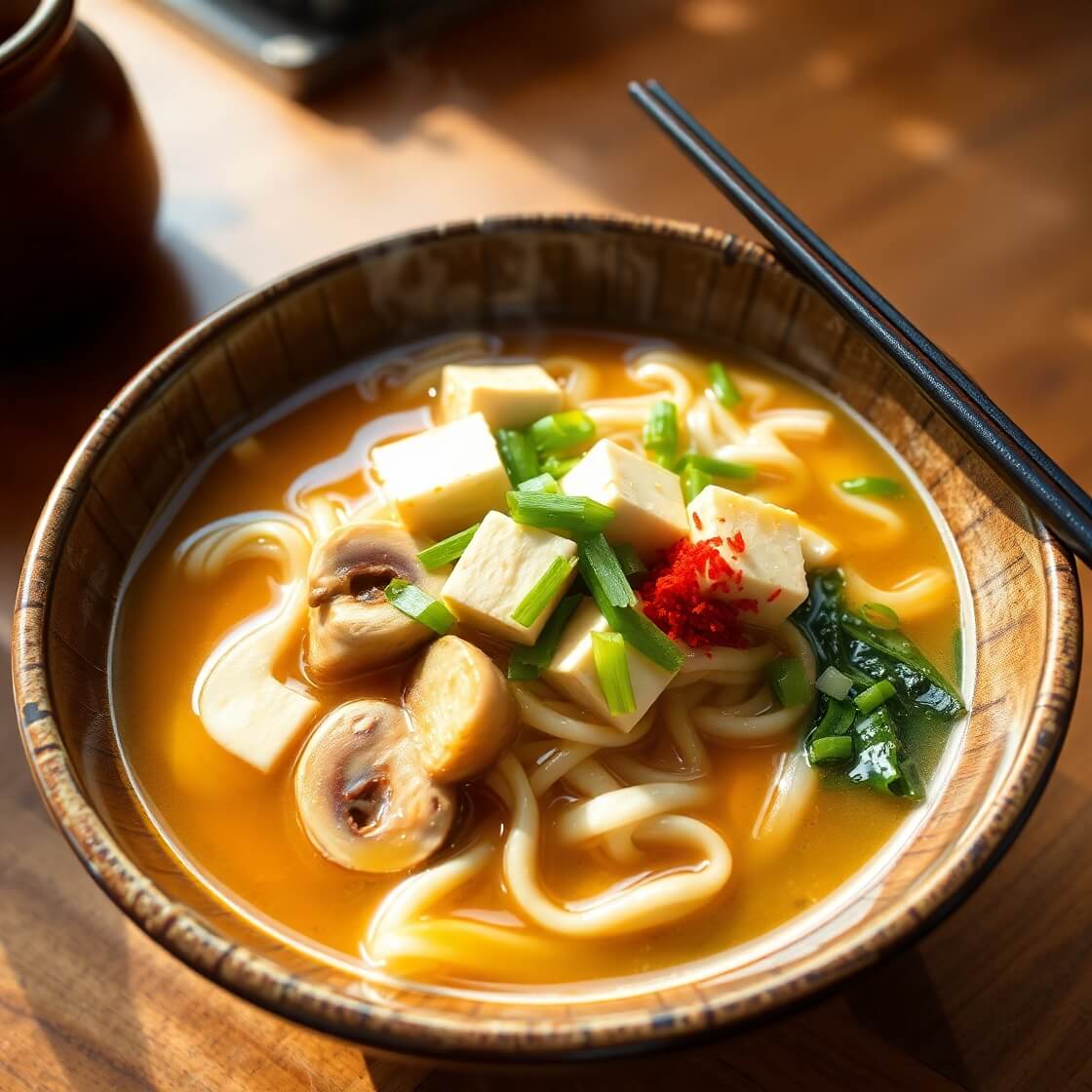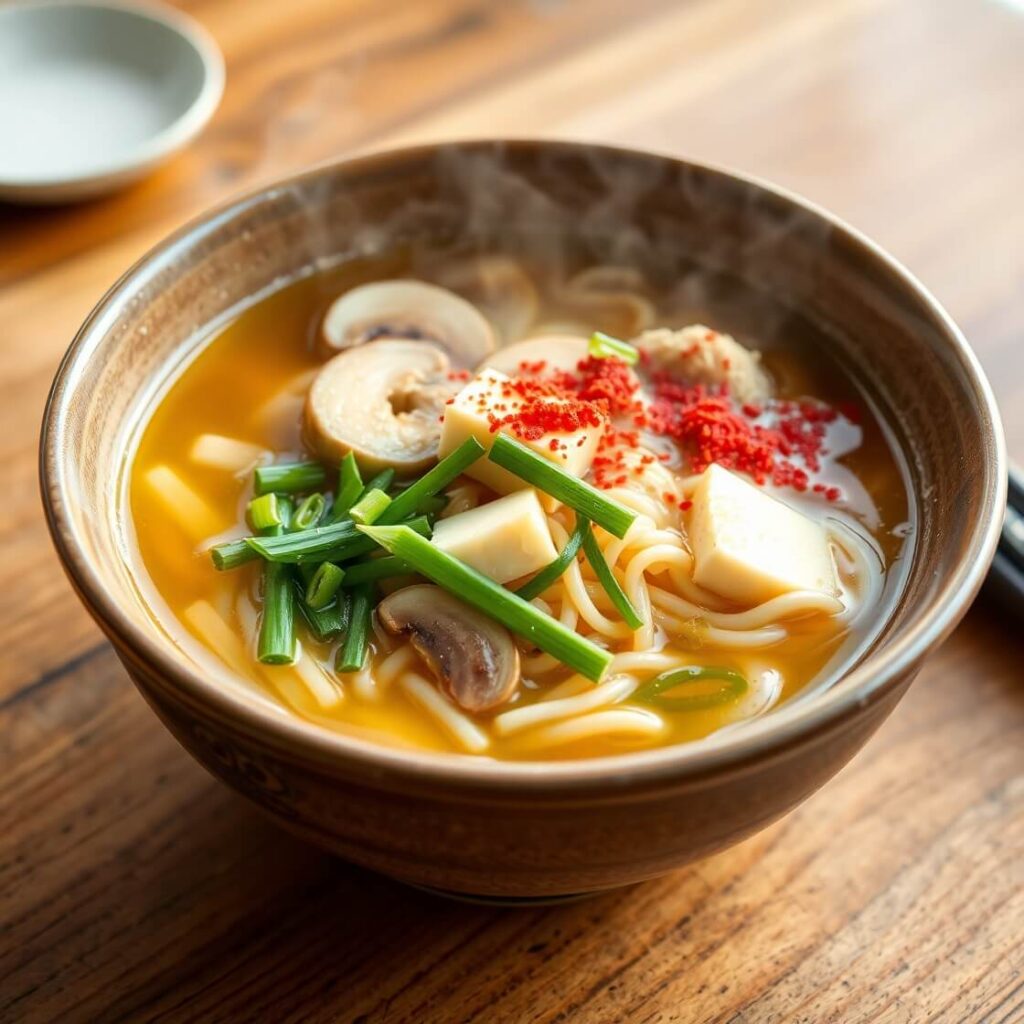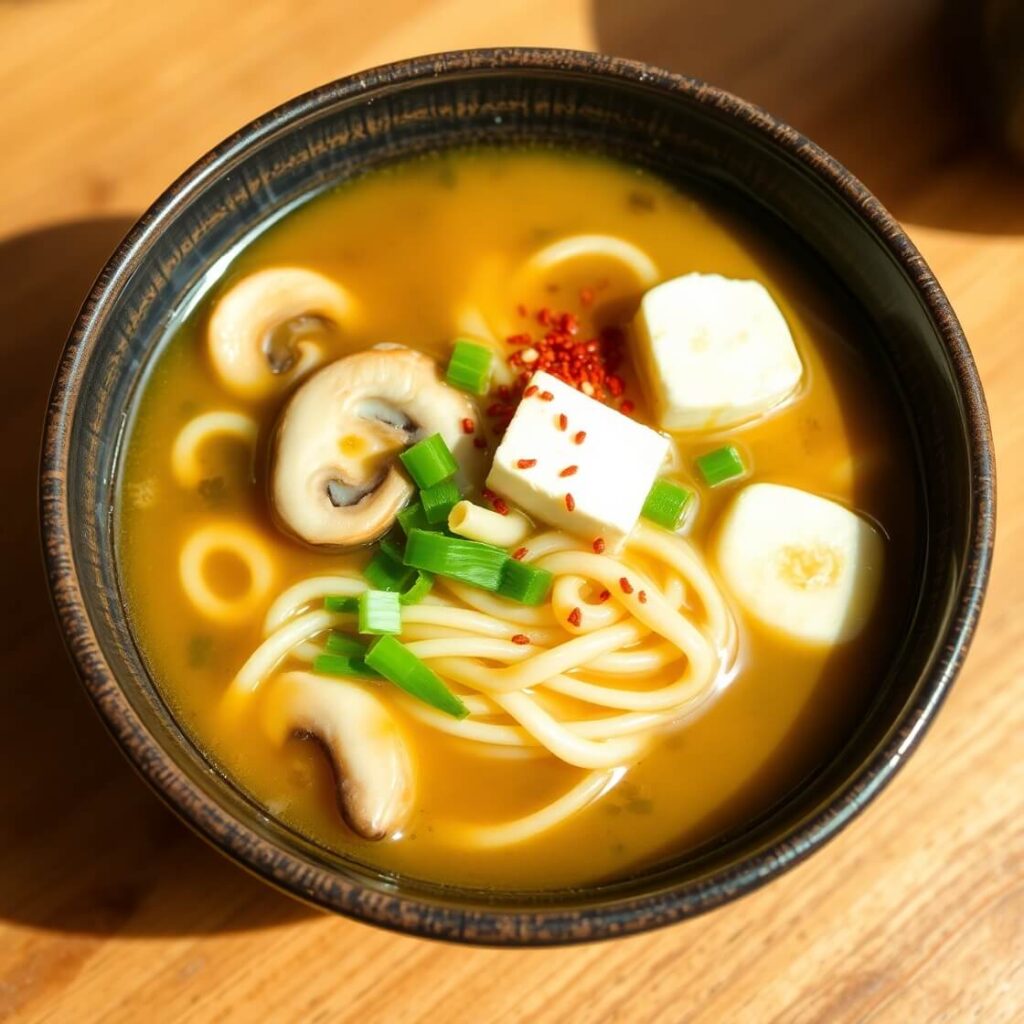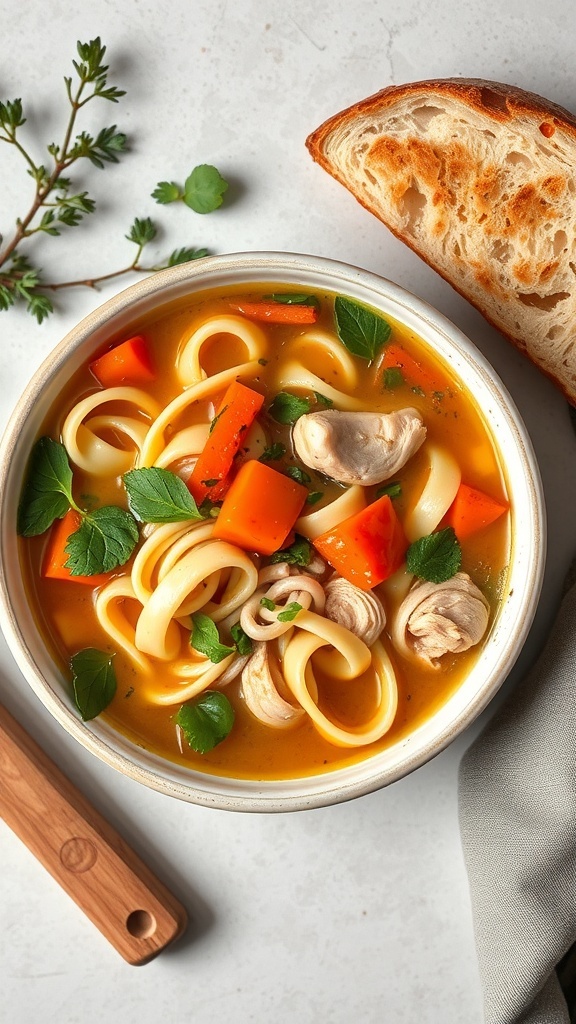Udon Noodle Soup

I remember the first time I fell in love with udon noodle soup—not in a restaurant, but at a tiny market stall tucked between two neon-lit shops in Kyoto. The winter chill had seeped through my coat, and my fingers were stiff from trying to navigate the narrow cobblestone streets. Then came the aroma: a warm, salty-sweet broth with chewy, pillowy noodles that seemed to hug every inch of my stomach. I slurped the noodles straight from a steaming bowl and felt instantly cocooned in comfort.
Years later, I’ve tried dozens of udon recipes at home, but there’s something special about making it in winter. It’s a dish that doubles as a warm hug and a celebration of simplicity—one pot, few ingredients, maximum satisfaction. My kids have started requesting it whenever snow dusts the yard, and my husband claims it’s the only soup that makes him linger over seconds without complaint.
Making udon at home isn’t complicated, but it does benefit from a little intention. The right broth, the texture of the noodles, and the gentle balance of flavors all play a part. Over the years, I’ve learned to keep the ingredients fresh, the broth slow-simmered, and the toppings customizable. It’s a ritual now: chopping vegetables, letting the aroma fill the kitchen, tasting the broth until it’s just right.
Why Winter Makes Udon Special
There’s a reason I reach for udon noodle soup as soon as the temperature drops. The thick wheat noodles are inherently warming, providing a chewy contrast to silky broth. And while the ingredients might be simple—dashi, soy sauce, mirin, a few vegetables—they combine to create a dish that feels luxurious in the heart of winter.
The seasonal tie-in isn’t just about warmth. Winter vegetables like spinach, napa cabbage, and shiitake mushrooms hold up beautifully in the broth. Their flavors deepen during the simmering process, and a soft poached egg on top adds richness without heaviness. When I serve it with a sprinkle of green onions and a hint of toasted sesame, it feels like the kind of home-cooked meal that turns ordinary evenings into mini celebrations.
Even the family enjoys experimenting with winter variations. Last December, my son insisted on adding tiny cubes of sweet potato, which surprisingly elevated the sweetness of the broth. And my daughter, who usually refuses greens, happily finished a bowl of spinach because it was “floating like snow.” These little seasonal touches make the recipe feel alive, evolving with each winter.
Pairings and Serving Ideas
While udon noodle soup is delightful on its own, I love pairing it with simple sides that complement its flavor without overwhelming it.
- Pickled vegetables: Quick-pickled carrots or daikon add a tangy crunch that contrasts the soft noodles.
- Tempura: Lightly battered vegetables or shrimp provide a textural pop that turns an everyday soup into a feast.
- Rice crackers or onigiri: Crunchy rice crackers or a small side of onigiri bring a nostalgic Japanese feel, especially for kids.
For serving, I prefer rustic, wide bowls that allow the noodles to move freely and the broth to cool just enough before slurping. A pair of wooden chopsticks feels essential for the authentic experience, and I usually keep a soup spoon nearby to savor the rich broth at the end.
Presentation is simple but effective: a few slices of shiitake mushrooms, a nest of noodles, a poached egg, and a sprinkling of green onions. For a festive winter touch, a small pinch of shichimi togarashi (Japanese seven-spice) adds warmth and a subtle heat.
Ingredients in Context
When I shop for udon soup ingredients, I’m particular about freshness and authenticity.
- Udon noodles: I prefer fresh over dried when possible. Fresh noodles have a springy bite that dried versions sometimes lack. If you only have dried, soak them a few minutes before cooking to soften.
- Dashi: The backbone of the broth. I usually keep a few packets of instant dashi for busy nights, but homemade kombu and bonito dashi is unbeatable in flavor. It’s lighter, cleaner, and allows the other ingredients to shine.
- Soy sauce and mirin: Look for naturally brewed soy sauce; it has a depth that cheap alternatives lack. Mirin adds a subtle sweetness that balances the saltiness.
- Vegetables: Seasonal picks work best. I use spinach, napa cabbage, carrots, and shiitake mushrooms in winter. Feel free to swap in whatever you have.
- Optional protein: Tofu, chicken, or thinly sliced beef work beautifully. For a vegetarian or vegan twist, stick to tofu and mushrooms.
I’ve learned that small choices in quality ingredients make a big difference in the final bowl. For instance, the first time I used low-quality soy sauce, the broth tasted flat. A quick swap to naturally brewed brought the flavor back to life.
Step-by-Step Instructions

Cooking udon noodle soup is comforting because it allows for a rhythm: chop, simmer, taste, repeat. Here’s how I usually do it:
- Prepare the broth: Combine dashi, soy sauce, mirin, and a pinch of salt in a medium pot. Bring to a gentle simmer over medium heat. The aroma should start filling your kitchen—salty, sweet, and umami-rich.
- Prep vegetables: Slice shiitake mushrooms thinly, chop spinach or cabbage, and julienne carrots. Smaller pieces cook evenly and absorb the broth.
- Cook proteins: If using tofu, cube it and add it just before the noodles. For chicken or beef, thin slices go directly into the simmering broth for 3–4 minutes until just cooked.
- Noodles: Boil udon noodles separately until tender, usually 8–10 minutes for fresh, 10–12 for dried. Drain and rinse briefly under warm water to prevent sticking.
- Combine: Add cooked noodles to the simmering broth, gently stir, and let everything mingle for a minute. Taste and adjust seasoning. A little more soy sauce or mirin can elevate the flavor if needed.
- Garnish: Serve in wide bowls, top with green onions, a poached egg if desired, and a sprinkle of sesame seeds or shichimi togarashi.
A quick tip: I once tried adding the noodles directly to the broth while it was still very hot, and they absorbed too much liquid, leaving the broth bland. Cooking them separately preserves both the noodle texture and the flavor balance.
Storage and Make-Ahead Tips

Udon soup is best enjoyed fresh, but leftovers can be practical.
- Broth: Store separately in an airtight container for up to 3 days in the fridge. Reheat gently—don’t boil, or the flavor can degrade.
- Noodles: Cooked noodles can be kept in a sealed container for a day, but avoid storing them in the broth, as they will absorb too much liquid. Reheat by briefly dunking in hot water.
- Vegetables: Leafy greens are best added fresh when reheating. Mushrooms and root vegetables reheat well in the warmed broth.
For busy nights, I sometimes pre-chop vegetables and pre-cook proteins, then assemble the soup in under 15 minutes. It keeps the warmth and comfort of homemade udon without extra stress.
Pro Notes and Mistakes to Avoid
Even though udon soup is simple at first glance, a few small mistakes can throw off the final flavor or texture. I’ve learned them the hard way over the years.
Don’t overcook the noodles: Fresh udon is tender yet chewy. Overcooked noodles become mushy and absorb too much broth. I once left mine simmering for an extra 5 minutes because I was distracted by a phone call. The noodles went soft, and the broth tasted slightly dull. Lesson learned: always set a timer.
Simmer, don’t boil: Broth develops its umami when simmered gently. Boiling can evaporate flavors too quickly and make the liquid taste flat. I like to bring the dashi to a low simmer before adding vegetables and proteins.
Balance the seasoning gradually: Soy sauce and mirin are the backbone of the flavor, but a heavy hand can make it too salty or overly sweet. Add a little at a time, taste, then adjust. You can always add more, but you can’t take it out.
Add greens last: Leafy vegetables like spinach or napa cabbage cook quickly and are best added at the end. Adding them too early results in limp, colorless leaves. I like to add greens right before serving so they retain their vibrant color and fresh flavor.
Egg timing matters: A poached or soft-boiled egg makes the soup luxurious, but add it at the right moment. Too early and it disintegrates, too late and it doesn’t warm through. My favorite method is to poach the egg separately, then float it on top just before serving.
FAQs About Udon Noodle Soup
Can I use dried udon noodles?
Absolutely. They take slightly longer to cook—about 10–12 minutes—but work perfectly in this recipe. Rinse them briefly under warm water after boiling to prevent sticking.
Is there a vegan version?
Yes! Use kombu-based dashi instead of bonito flakes, and skip any meat or egg toppings. Mushrooms, tofu, and winter vegetables will provide plenty of flavor and texture.
Can I make this ahead for meal prep?
You can, but keep the components separate. Store the broth, cooked noodles, and toppings in separate containers. Assemble and heat when ready to eat for best texture.
What vegetables work best in winter?
Spinach, napa cabbage, shiitake mushrooms, carrots, and even small pieces of sweet potato work beautifully. These vegetables hold up in simmering broth and provide seasonal flavor.
Can I freeze udon soup?
Broth can be frozen for up to 2 months. Cooked noodles and vegetables generally don’t freeze well, so I recommend storing those separately and assembling fresh when you’re ready.

Udon Noodle Soup
- Total Time: 25 minutes
- Yield: 2 1x
- Diet: Vegetarian
Description
A warm and comforting Japanese classic featuring thick, chewy udon noodles swimming in a savory dashi-based broth seasoned with soy sauce and mirin. This soup is simple, quick to prepare, and endlessly versatile with mushrooms, tofu, or thinly sliced meats. Perfect for cozy dinners or light lunches, it delivers rich umami flavor with a delicate balance of salty and sweet notes.
Ingredients
- 6 oz fresh or frozen udon noodles
- 3 cups dashi stock (homemade or instant powder)
- 2 tbsp soy sauce
- 1 tbsp mirin
- 1 cup sliced shiitake mushrooms (optional)
- 4 oz soft tofu, cubed (optional)
- 2 scallions, thinly sliced
- 1 tsp toasted sesame oil
- Shichimi togarashi or chili oil (optional)
Instructions
- Combine dashi stock, soy sauce, and mirin in a pot. Bring to a gentle simmer.
- Cook udon noodles separately according to package instructions. Drain and set aside.
- Add mushrooms to the broth and simmer for 3-4 minutes.
- Gently add tofu or protein of choice and cook until heated through.
- Divide noodles between bowls and ladle broth with toppings over them.
- Garnish with scallions, drizzle with sesame oil, and sprinkle chili powder if desired. Serve hot.
Notes
- Use fresh or frozen udon for best texture.
- Adjust soy sauce and mirin to taste before serving.
- Avoid overcooking noodles to keep chewiness.
- Add vegetables or protein as you like for variety.
- Prep Time: 10 minutes
- Cook Time: 15 minutes
- Category: Soup
- Method: Simmering
- Cuisine: Japanese
Nutrition
- Serving Size: 2
- Calories: 280
- Sugar: 2g
- Sodium: 900mg
- Fat: 5g
- Saturated Fat: 1g
- Unsaturated Fat: 3g
- Trans Fat: 0g
- Carbohydrates: 45g
- Fiber: 3g
- Protein: 12g
- Cholesterol: 0mg







